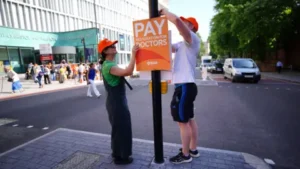This Popular Bond ETF Might Be Marriage Material. Here’s the Best Way to Say ‘I Do.’
What do you get when you take the option collar, the options strategy I write about regularly for Barchart, and remove the covered call, arguably the least important yet most popular piece? The answer is a “married put strategy.” And in this article, I’m going to explain why this is a good time to leave the covered call at home.
In the current market environment, the exchange-traded fund (ETF) I’m focusing on might be better off without the covered call. Why? Sinking option volatility. That makes options cheaper. But since the put side of a collar is bought, cheap is good.
Invest in Gold
However, the call side of the options collar involves selling a covered call option. The usual motivation for that extra step is to pay for the put option that guards a stock or ETF from diving too far down. That covered call option is also somewhat inexpensive these days. And when we’re talking about selling away some of our potential upside profits, in exchange for some cash flow now to reduce the cost of the puts, it doesn’t make as much sense. Because the amount received for the call-writing transaction is not very much, relative to recent history.
A case in point for why a married put strategy might make more sense now than an option collar strategy is the iShares 20+ Year Treasury Bond ETF (TLT), which as shown below has an IV Rank of 15%.
That means over the past 12 months, the volatility level of TLT has been higher than the current 14% level 85% of the time. This means we don’t have to worry too much about volatility here.
As a side note, fans of covered call ETFs should pay close attention. Given lower volatility levels, the risk management provided by covered call ETFs today is much less powerful than it has been throughout the rest of 2025.
As with collars, there are many ways to approach the combination of marrying TLT shares and a TLT put option for every 100 shares owned. But the takeaway from this one example below is that I can go out to Nov. 21, and assuming I bought TLT around $88 a share, I can also buy a put struck at $88.

This means that except for the cost to buy the puts, I can’t end up with less than $88 a share of value… no matter what happens with interest rates or how much TLT falls. Plus, the cost to buy the puts is only $2.61 here, so about 3% of that $88 strike price.
Bottom line: 3% is my worst-case loss.
My upside? Unlimited through Nov. 21, with that protection in place. We have recently experienced a period in which the long end of the yield curve has been quiet and not very volatile. It is as if it is trying to make up its mind what to do. If the recent saber-rattling in Washington tips in the direction of lower rates, TLT could be a big winner.
However, in an uncertain, politically charged situation like this, having relatively cheap put protection can be a valuable hedge. And as long as the covered call part of a collar is not especially attractive, this could be an opportunity to pursue unfettered upside. That’s one key advantage of the married put strategy versus the collar.
But if you profit from this trade… Please, no gifts for the happy couple.
On the date of publication, Rob Isbitts did not have (either directly or indirectly) positions in any of the securities mentioned in this article. All information and data in this article is solely for informational purposes. This article was originally published on Barchart.com








